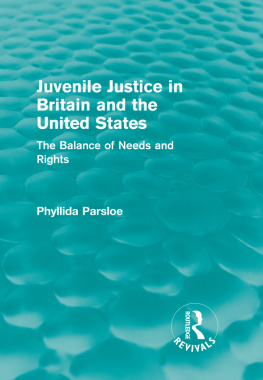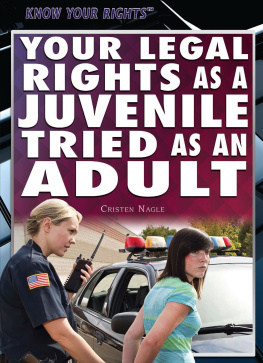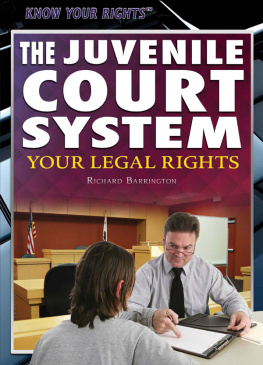Wild Arabs and savages
A history of juvenile justice in Ireland
Paul Sargent
Manchester University Press
Manchester and New York
distributed in the United States exclusively by Palgrave Macmillan
Copyright Paul Sargent 2014
The right of Paul Sargent to be identified as the author of this work has been asserted by him in accordance with the Copyright, Designs and Patents Act 1988.
Published by Manchester University Press
Oxford Road, Manchester M13 9NR, UK
and Room 400, 175 Fifth Avenue, New York, NY 10010, USA
www.manchesteruniversitypress.co.uk
Distributed in the United States exclusively by
Palgrave Macmillan, 175 Fifth Avenue, New York,
NY 10010, USA
Distributed in Canada exclusively by
UBC Press, University of British Columbia, 2029 West Mall,
Vancouver, BC, Canada V6T 1Z2
British Library Cataloguing-in-Publication Data
A catalogue record for this book is available from the British Library
Library of Congress Cataloging-in-Publication Data applied for
ISBN 978 0 7190 8916 9
First published 2014
The publisher has no responsibility for the persistence or accuracy of URLs for any external or third-party internet websites referred to in this book, and does not guarantee that any content on such websites is, or will remain, accurate or appropriate.
Typeset in Minion Pro by
Servis Filmsetting Ltd, Stockport, Cheshire
Contents
Figures
Preface
The Irish juvenile justice system underwent unprecedented changes in the first decade of the twenty-first century. These changes are reflected somewhat in the language used to describe the system and certain elements of it. The term youth justice is commonly used to refer to the present system and appears to embody developments as diverse as diversion, restorative justice, high support and special care, along with more traditional elements such as detention. In an attempt to understand how we have come to speak about youth justice, this book looks at the key historical developments that resulted in the emergence of the youth justice system.
Although the origins of juvenile justice can be traced back over two hundred years, there has been no attempt to write a complete history of juvenile justice in Ireland. Some aspects of the system have been accounted for, such as the emergence of the borstal institution and the large network of industrial schools, but these provide only partial glimpses rather than an overall context within which to locate such historical developments.
When looking back over the history of juvenile justice in Ireland one is struck by the overall lack of co-ordination and the general ad hoc manner in which the system emerged. What is also striking about the emergence of the Irish system is the relatively minor role played by the state in its development and management from the mid-nineteenth century to the late twentieth century. In this regard, the state abdicated its responsibilities mainly to Catholic religious organisations. In stark contrast, the state has now taken centre stage in managing the newly emerging youth justice system. Evidence of this can be seen in the establishment of both the Irish Youth Justice Service and the Office of the Minister for Children and Youth Affairs.
Utilising a wide range of previously unused primary and secondary sources, this book charts the development of the Irish juvenile justice system from its inception at the beginning of the nineteenth century. The book does not attempt to evaluate the system in terms of its effectiveness or its compliance with international standards. Rather, it attempts to open up the youth justice space along four separate lines of enquiry: how the system became visible; the rationalities underlying the system; the techniques used to govern the child and young person; and the forms of childhood identity employed by those governing. In this sense, the book is not a traditional history but an attempt to do two things at once: unsettle the taken-for-granted nature of the discourse on juvenile justice and map previously unmapped territory. It is hoped that the book, having broken new ground, will inspire others to undertake further research in this area.
Acknowledgements
I wish to express my deepest thanks to Anna, Grace and Clara whose patience and support made it possible for me to write this book. Special thanks are also due to my parents, who have always supported me.
Thanks also go to the staff of Manchester University Press for their constant assistance and expertise.
I am indebted to Eoin OSullivan for his inspiration and guidance over a number of years. His support and encouragement through all the stages of this project is deeply appreciated. His willingness to share his knowledge and experience has shaped my understanding of juvenile justice and child welfare in Ireland. Likewise special thanks are due to Helen Buckley, who has been another source of great support and inspiration, and Shane Kilcommins for his generous encouragement. I am also grateful for the support of my colleagues and the staff in the Department of Social Work and Social Policy, Trinity College Dublin, which enabled me to complete this project.
I wish to express my sincerest gratitude to the following people, whose expertise, help and encouragement have been invaluable in the completion of this book: my former colleague and friend Jim McGuirke; Brendan Mangan; Seamus Fitzpatrick; Siobhan Young; Nicola Carr; Bronagh Gibson; Jennifer Armstrong; Teresa Whittington of the Central Catholic Library; the staff of Milltown Park Library; Donal Fenlon, Royal Society of Antiquaries of Ireland; Elizabeth Flynn of Cnamh, formerly the Catholic Protection and Rescue Society of Ireland; the staff of the National Library of Ireland; and the staff of the Library at Trinity College Dublin.
Chronology
| 1801 | Smithfield Penitentiary established in Dublin for juveniles awaiting transportation |
| 1853 | Report of the Select Committee on Criminal and Destitute Juveniles |
| 1858 | Reformatory Schools (Ireland) Act 1858. First reformatory school for Roman Catholic girls opens at High Park, near Drumcondra, Dublin |
| 1859 | First reformatory school for boys opens at Glencree, County Wicklow |
| 1868 | Industrial Schools (Ireland) Act 1868 |
| 1869 | First industrial school certified at Lakelands, near Sandymount, Dublin |
| 1884 | Report of the (Aberdare) Commission on Industrial and Reformatory Schools |
| 1895 | Report of the Departmental Committee on Prisons (Gladstone Report) |
| 1906 | First borstal institution in Ireland opens at Clonmel, County Tipperary |
| 1908 | Children Act 1908 |
| 1924 | Responsibility for administration and supervision of reformatory and industrial schools passes to the Minister for Education |
| 1936 | Report of Commission of Inquiry into the Reformatory School and Industrial School System |
| 1941 | Children Act 1941 |
| 1944 | |







